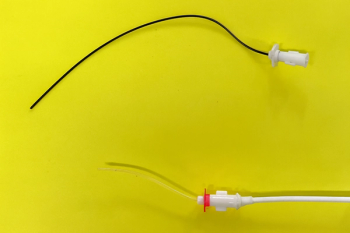
Stones vs. crystals: Management and prevention (Proceedings)
Crystalluria: Struvite crystalluria occurs in greater than 50% of healthy dogs, including animals without urinary tract infections; these crystals are also common in healthy cats. Incidental struvite crystalluria occurs because the mineral components of these crystals (magnesium, ammonia, phosphate) are normally excreted in large amounts into urine, and supersaturation leads to precipitation.
Struvite
Crystalluria: Struvite crystalluria occurs in greater than 50% of healthy dogs, including animals without urinary tract infections; these crystals are also common in healthy cats. Incidental struvite crystalluria occurs because the mineral components of these crystals (magnesium, ammonia, phosphate) are normally excreted in large amounts into urine, and supersaturation leads to precipitation. Crystalluria by itself does not result in clinical signs of lower urinary tract disease. In the absence of clinical signs of lower urinary tract disease, urine culture can be considered in animals with heavy struvite crystalluria and a history of bacterial urinary tract infections, or in animals with concurrent diseases that predispose to urinary tract infections. Intervention should be considered when large numbers of crystals are present in a patient with a history of obstruction (because struvite crystals make up a large component of many plugs) or a history of sterile struvite urolithiasis. Preventative therapy is the same as for urolith prevention.
Urolithiasis: Struvite uroliths in dogs are due to bacterial urinary tract infection with urease-producing bacteria in greater than 95% of cases; in cats, sterile (i.e. not associated with infection) struvite uroliths are diagnosed more frequently than in dogs. Struvite urolithiasis primarily occurs in female dogs because of the higher prevalence of bacterial urinary tract infections. Urine is usually (but not always) alkaline, and in many cases sediment examination reveals struvite crystals and active urine sediment due to the concurrent infection. Urine culture should result in growth of a urease-producing bacterial species, most commonly Staphylococcus sp. or Proteus sp.; less common urease-producing infections include Klebsiella sp.; Corynebacterium sp.; Enterococcus sp.; and Mycoplasma sp. The presence of a non-urease producing bacterial species usually implies an alternative stone type with secondary infection. Imaging typically reveals radio-opaque uroliths; the size and number may widely vary, although infection-induced nephroliths are frequently 'staghorn' in shape.
Struvite uroliths can be dissolved with a combination of diet and drugs. Hill's S/D is the only commercial diet verified to be sufficiently low in protein, magnesium, and phosphorus, is acidifying, and has been proven to dissolve struvite uroliths in a prospective study. Unfortunately, S/D is not nutritionally complete, and therefore should not used as a long-term maintenance diet. In conjunction with dietary dissolution of uroliths, resolution and prevention of urolith recurrence requires identification, treatment, and prevention of concurrent bacterial urinary tract infections. After culture and sensitivity testing, an appropriate antibiotic should be administered until the urolith has been completely dissolved (i.e. well beyond the standard two weeks of antibiotics typically prescribed for treatment of urinary tract infections). After beginning dissolution therapy, patients should be rechecked approximately every 4 weeks. Urinalysis and urine culture should confirm the continued effectiveness of therapy and owner compliance, and survey radiographs are taken to monitor progression of dissolution. Therapy should be continued for 2-4 weeks beyond radiographic resolution of the stone. In some cases surgical intervention may be required rather than attempting dissolution, particularly in the presence of severe clinical signs, obstruction, or pyelonephritis. Prevention of recurrence of infection-associated struvite urolithiasis should be focused on prevention of urinary tract infections. Recurrence of uroliths is usually due to incomplete dissolution of stones, and/or persistence of infection, or due to an underlying impairment of the normal urinary tract defense mechanisms leading to recurrent infections.
For sterile struvite uroliths (as occurs in cats and very, very rarely in dogs) no good data exists for any struvite-preventive diet. It may be sufficient to simply switch the diet to anything the patient will readily consume; Hill's W/D or Hill's C/D Multicare are oftentimes recommended as a well-tolerated diet that in theory minimize struvite urolith formation. Canned diets increase water intake, and thus urine production, and may help with uroliths prevention by preventing supersaturation with the component minerals.
Calcium oxalate
Crystalluria: Calcium oxalate crystalluria is also a common finding in healthy dogs and cats; as with struvite crystalluria, in the vast majority of patients calcium oxalate crystals do not merit intervention. In rare cases calcium oxalate crystalluria may be associated with ethylene glycol ingestion or diseases that cause hypercalcemia or promote calciuria (e.g. hyperparathyroidism). Therefore, a full minimum database, particularly serum calcium, BUN, and creatinine, should be considered in patients with continued presence of calcium oxalate crystalluria and other clinical signs of disease. Intervention in animals with calcium oxalate crystalluria but no uroliths may be considered when large numbers of crystals are present in a breed that is predisposed to urolith formation (see below), and should definitely be instituted in animals with a history of calcium oxalate urolithiasis. Preventative therapy is the same as for urolith prevention.
Urolithiasis: The pathogenesis of calcium oxalate urolithiasis is unknown, and may be different or more complex than that of calcium oxalate crystalluria. Calcium oxalate uroliths cannot be dissolved and therefore require invasive procedures for removal. As such, it should be stressed to owners that management and prevention require strict owner compliance and regular monitoring. Unfortunately, even with strict adherence to current recommendations, recurrence rates for calcium oxalate uroliths remain high. Predisposed dog breeds include the Miniature Schnauzer, Lhasa Apso, Bichon Frise, Pomeranian, Shih Tzu, Maltese, Miniature Poodle, Yorkshire Terrier, and Chihuahua. In cats, almost 100% of upper urinary tract uroliths are calcium oxalate as well as the majority of lower urinary tract uroliths. Calcium oxalate uroliths are also associated with diseases that increase urinary calcium excretion, particularly hyperadrenocorticism (dogs), hyperparathyroidism (dogs and cats), and idiopathic hypercalcemia (cats).
Clinical signs secondary to uroliths, recurrent/persistent infection, partial or total obstruction of the urinary tract, and high risk of obstruction are the most common indications for intervention. Options for uroliths removal include surgery, extracorporeal shock wave lithotripsy (ESWL), laser lithotripsy, voiding urohydropropulsion, and catheter-assisted retrieval. Voiding urohydropropulsion and catheter-assisted retrieval are less invasive procedures and ideal for retrieval of small uroliths. Surgical removal of ureteroliths and nephroliths is more technically demanding than removal of cystoliths, and associated with higher morbidity and mortality. Some nephroliths and ureteroliths may not require immediate intervention, and in appropriate patients monitoring and medical therapy to promote voiding and slow a possible increase in size may be considered rather than immediate surgery.
Goals for prevention of calcium oxalate urolith formation are a reduction in dietary protein content, alkalinization of urine, an increase in urine concentration of calcium oxalate inhibitors, a decrease in urine specific gravity, and a proportionate decrease in dietary calcium and oxalate. Some of the most widely used diets in dogs for prevention of this uroliths type include Hill's U/D, Royal Canin S/O, and Hill's W/D; Hill's U/D has the most anecdotal and published evidence in the veterinary literature. Hill's W/D should be used primarily in patients that cannot tolerate the high fat content of the other diets, such as patients with a history of pancreatitis or hyperlipidemia, and in dog breeds that are predisposed to development of carnitine or taurine-deficient cardiomyopathy; however, if this substitution is made, potassium citrate should be added to modify the urine pH to appropriately alkaline levels. In cats, available diets include Hill's C/D Multicare or Royal Canin S/O. Hill's W/D with potassium citrate has also been attempted, particularly in cats with idiopathic hypercalcemia.
Alkalinization of urine is recommended because calcium oxalate precipitation is promoted at urine pH lower than 7.0. Potassium citrate is the drug of choice, and Hill's U/D and K/D and Royal Canin S/O have been formulated to alkalinize by addition of this drug. Nevertheless, additional potassium citrate supplementation may be required in some cases. Dogs with hyperkalemia secondary to potassium citrate (a rare occurrence) can be given sodium bicarbonate instead. Note that alkalinization of urine is difficult-to-impossible to achieve without a concurrent low protein diet—potassium citrate alone without a change in diet is therefore not recommended as sole therapy. Increased urine concentration of calcium oxalate inhibitors is also primarily accomplished by administration of potassium citrate; citrate is an in vitro inhibitor of crystal formation. Decreased urine specific gravity is desirable as increased urine volume prevents supersaturation with component minerals. This is accomplished by giving a canned diet and a diet low in protein. A decrease in dietary calcium and oxalate theoretically seems to make sense, but it is not recommended to lower these below minimal requirements, and a concurrent decrease in both minerals is likely needed.
Other therapies have been recommended as well, but are either unproven or are not used as first-line options. Vitamin B6 increases metabolism of oxalate precursors to glycine instead of oxalate. No controlled studies exist in veterinary patients, and this drug is not routinely used, but it appears to be relatively harmless. In those cases where optimal therapy fails to prevent calcium oxalate urolith recurrence or persistent calcium oxalate crystalluria, thiazide diuretics (hydrochlorothiazide) should be prescribed. These diuretics induce diuresis and also promote calcium reabsorption (therefore decreasing urine calcium concentration).
Ammonium urate/uric acid
Crystalluria: Urate crystals may be uric acid, sodium urate, or ammonium urate. Unlike struvite and calcium oxalate, uric acid crystals and uroliths should not be considered normal or incidental findings on urinalysis. Urine supersaturation may occur with impaired liver handling of uric acid and ammonia (i.e. in animals with hepatic disease, particularly portosystemic shunts), or in animals with inborn errors of metabolism that impair metabolism of uric acid or increase uric acid secretion into urine. Breeds with known increased risk of abnormal urate handling include Dalmatians and English Bulldogs. Asymptomatic urate crystalluria in an atypical breed should be followed by a full minimum data to screen for possible hepatic dysfunction, and a liver challenge test (serum bile acids or ammonia tolerance) if needed. The primary disease should be treated in animals with confirmed hepatic dysfunction; specific therapy to decrease crystalluria is not always needed. Intervention in patients without hepatic dysfunction and without a history of urolith formation should primarily be considered in male dogs (females rarely develop urinary tract obstruction secondary to urolithiasis). Intervention should also be considered in young animals; animals greater than 6-8 years of age at the time that urate crystalluria is first diagnosed are less likely to progress from urate crystal formers to urate urolith formers. Therapy for urate crystal prevention is the same as for urolith prevention (see below).
Urolithiasis: Urate urolithiasis should be suspected in animals with clinical signs of lower urinary tract disease and radiolucent uroliths identified via contrast radiographs. Dalmatians and English Bulldogs with radiolucent stones can often be assumed to have uroliths due to genetic predisposition; nevertheless remember that hepatic dysfunction can occur in any breed. When urate uroliths are diagnosed in other dog breeds, very young Dalmatians and English Bulldogs, and cats, hepatic function testing should be performed, including a minimum database and liver function challenge testing. The median age of dogs at first episode of urate urolithiasis not associated with hepatic dysfunction is 3.5 years.
Urate uroliths can be dissolved via dietary and drug therapy. Medical therapy should be a last resort in patients with liver dysfunction. If PSS is present, surgical intervention is ideal; uroliths can be removed at the time of surgery via cystotomy, or prior to surgery via voiding urohydropropulsion or catheter-assisted retrieval if small. Additionally, urate uroliths associated with PSS may dissolve spontaneously after correction of the anomalous vessel. In patients with other causes of hepatic dysfunction, allopurinol is contraindicated, as this drug requires hepatic activation. If no hepatic dysfunction present, then medical intervention can promote dissolution. A low protein diet (Hill's U/D) should be administered. Complete owner compliance is essential; compliance and effectiveness of this diet can be confirmed by monitoring urine specific gravity (should be <1.025) and serum BUN (should be <10 mg/dl). Potassium citrate may be required if urine alkalinization is not achieved with U/D alone. Allopurinol (10-15 mg/kg q8-12h) should be administered until complete dissolution.
Prevention of urate urolith recurrence usually requires correction of underlying disease in dogs with hepatic dysfunction. Long-term therapy with Hill's L/D may delay recurrence, but this is theoretical rather than documented by a controlled study. In dogs with metabolic errors, dietary therapy is used alone initially, followed by concurrent drug therapy if required. Hill's U/D is recommended in most breeds; Hill's K/D is used in patients with concurrent renal disease, or patients that require a low protein diet but are at risk for taurine and/or carnitine-deficient dilated cardiomyopathy. In patients where dietary therapy alone fails to prevent urate recurrence, owner compliance should be confirmed. If compliance is not an issue, then after dissolution of the recurrent uroliths, long-term allopurinol therapy should be instituted.
Newsletter
From exam room tips to practice management insights, get trusted veterinary news delivered straight to your inbox—subscribe to dvm360.





